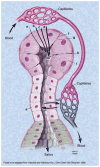Salivary diagnostics
- PMID: 19627522
- PMCID: PMC2909324
- DOI: 10.1111/j.1601-6343.2009.01454.x
Salivary diagnostics
Abstract
The ability to monitor health status, disease onset and progression, and treatment outcome through non-invasive means is a most desirable goal in the health care promotion and delivery. There are three prerequisites to materialize this goal: specific biomarkers associated with a health or disease state; a non-invasive approach to detect and monitor the biomarkers; and the technologies to discriminate the biomarkers. A national initiative catalyzed by the National Institute of Dental & Craniofacial Research (NIDCR) has created a roadmap to achieve these goals through the use of oral fluids as the diagnostic medium to scrutinize the health and/or disease status of individuals. Progress has shown this is an ideal opportunity to bridge state of the art saliva-based biosensors, optimized to disease discriminatory salivary biomarkers, for diagnostic applications. Oral fluid being the 'mirror of body' is a perfect medium to be explored for health and disease surveillance. The translational applications and opportunities are enormous.
Figures




References
Publication types
MeSH terms
Substances
Grants and funding
LinkOut - more resources
Full Text Sources
Other Literature Sources

